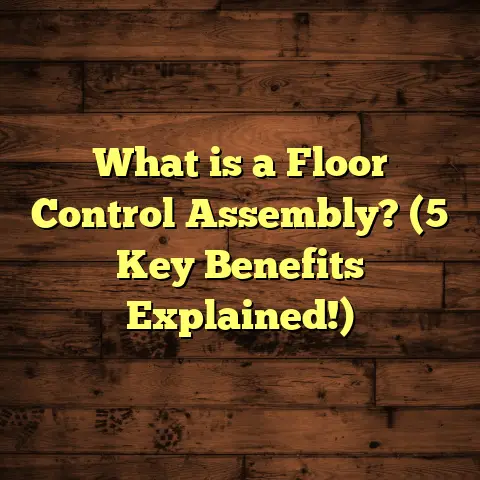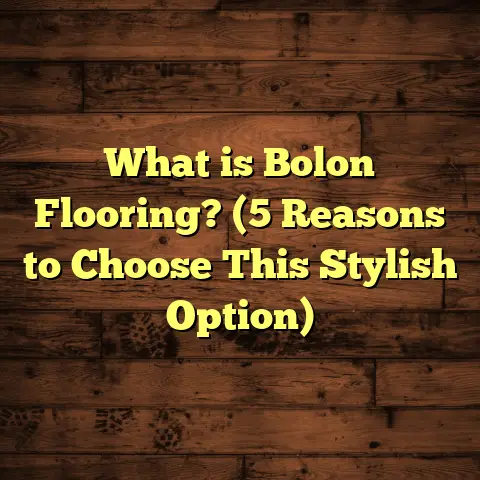What is Epoxy Flooring for Garage? (5 Benefits You Must Know)
I still remember the first time I stepped into a garage with epoxy flooring. The surface was smooth, glossy, and had this almost futuristic vibe that caught my attention immediately. It wasn’t just about looks — the floor felt durable and clean, and even after hours of walking and working on it, there wasn’t a hint of dirt or wear. That experience stuck with me and shaped how I view garage floors today.
What Is Epoxy Flooring for Garage?
Epoxy flooring is essentially a coating applied over concrete floors, made from a combination of resin and hardening chemicals. When these two components mix, they create a tough, shiny surface that sticks firmly to the concrete below. This type of flooring has become increasingly popular for garages because it offers protection and a polished look all at once.
What sets epoxy apart from regular paint or plain concrete is its chemical makeup. The resin-hardener combo creates a bond that is resistant to stains, scratches, and even chemicals like oil or brake fluid. This makes it perfect for garages where spills and heavy use are common.
Epoxy floors are not just about aesthetics—they are about creating a functional workspace that stays strong and clean for years to come. It’s a smart choice that blends appearance with performance.
Why Choose Epoxy for Your Garage?
If you’re like me, you want your garage to be more than just a place to park. Maybe you use it as a workshop or storage area, or maybe you just want it to feel clean and inviting. Epoxy flooring can make that happen easily.
1. Durability That Lasts
One of the biggest advantages of epoxy flooring is how tough it is. I’ve seen garages with epoxy floors that have lasted over 10 years without needing repairs. The coating handles heavy foot traffic, dropped tools, and even the weight of cars without cracking or chipping.
To give you a better idea, standard concrete has a compressive strength of about 3,000 psi (pounds per square inch). Epoxy coatings can add an extra layer of protection that significantly enhances this strength, often increasing the surface’s resistance to wear by up to 50%. What this means practically is that your floor can handle more abuse without showing signs of damage.
In one of my projects, a mechanic’s garage had epoxy flooring installed over five years ago. Despite daily exposure to car lifts, heavy tools dropped accidentally, and chemical spills, the floor still looked nearly new. That durability speaks volumes about epoxy’s value.
2. Resistance to Chemicals and Stains
If you’ve ever accidentally spilled motor oil or antifreeze on your garage floor, you know how hard it can be to clean up. Epoxy floors resist these kinds of stains because the coating is non-porous. Nothing soaks in.
In one case study involving an auto repair shop, epoxy floors reduced cleaning time by 30% compared to their old bare concrete floors. That’s not just about looking good—it means less time scrubbing and more time being productive.
The chemical resistance also protects against acids, gasoline, and other harsh substances commonly found in garages. Over time, plain concrete can absorb these chemicals causing discoloration and structural damage. Epoxy shields the surface from these effects.
3. Enhanced Safety
Slippery floors? Not fun when you’re rushing around your garage. Epoxy flooring can be finished with textures or additives to improve grip. I’ve personally used epoxy mixed with fine sand particles in my own garage to prevent slipping, especially during wet conditions.
Research from the National Floor Safety Institute shows that textured epoxy coatings can reduce slip accidents by up to 40%. That’s a big deal if your garage doubles as a workspace or play area.
Additionally, epoxy coatings often come with reflective properties that improve lighting in darker spaces. This boost in visibility helps reduce accidents further.
4. Easy Maintenance
Cleaning an epoxy garage floor is surprisingly simple. Because the surface is smooth and sealed, dust, dirt, and spills wipe off with basic soap and water. I once had a tough grease spill during a weekend project, but with epoxy flooring, a quick mop-up was all it took.
In fact, epoxy-coated floors can reduce maintenance costs by 25% compared to uncoated concrete because they don’t require resealing or heavy-duty cleaning products.
I often recommend homeowners schedule monthly quick cleanings and quarterly deeper cleans using mild detergents for best results without damaging the floor.
5. Aesthetic Appeal
Let’s be honest — garages don’t always get the love they deserve when it comes to looks. Epoxy flooring changes that completely. You can pick from colors, patterns, and finishes that match your style.
I experimented with flecked epoxy in my garage—small colored chips embedded in the surface—and it gave the floor a speckled look that hides dirt well while adding personality. Plus, the glossy finish brightens up the space by reflecting light better.
Many homeowners choose colors that complement their home’s interior or opt for neutral grays or blacks for a sleek industrial vibe.
How Is Epoxy Flooring Installed?
You might wonder what goes into installing epoxy flooring on your garage floor. From my experience and several projects I’ve handled, the process involves some preparation but isn’t overly complicated if done right.
Step 1: Surface Preparation
This is the most critical step. The concrete floor must be cleaned thoroughly—think oil stains, dirt, and dust removed completely. Sometimes, professionals grind the surface lightly to ensure the epoxy bonds well.
I once had a client try skipping this step—big mistake! The coating peeled off in spots within months.
Grinding also opens up the pores of concrete to allow epoxy penetration and improve adhesion strength.
Step 2: Repair Any Cracks or Holes
Concrete isn’t perfect; cracks or holes need fixing before applying epoxy. Using concrete patching compounds fills gaps so the surface is smooth and even.
This step can’t be rushed because any imperfections show through the coating if not addressed well.
Step 3: Primer Application
Some epoxy systems require a primer coat to improve adhesion and seal the concrete pores. This step varies depending on the product but usually takes about an hour to dry.
Primers also help reduce bubbling or blisters under the final coating by sealing moisture vapor emissions from concrete slabs.
Step 4: Mixing and Applying Epoxy
The resin and hardener are mixed carefully according to instructions. Then, using rollers or squeegees, the mixture is spread evenly over the floor.
You’ll want to work in small sections because epoxy starts curing quickly—usually within 20-30 minutes after mixing.
I recall one job where poor timing caused uneven application because we tried covering too large an area at once—lessons learned!
Step 5: Optional Topcoat or Texture
After the base layer cures (usually 24 hours), many choose to add a topcoat for extra protection or texture materials for grip.
The topcoat protects against UV damage and yellowing for floors exposed to natural light near garage entrances.
Step 6: Curing Time
Complete curing can take up to 72 hours before heavy use is recommended. Patience here pays off with long-lasting results.
Temperature and humidity impact curing duration significantly; warmer environments speed it up; cold slows it down.
How Do You Maintain Epoxy Floors?
One of my favorite parts about epoxy is how little effort it needs to stay looking great.
- Regular Sweeping: Dust and grit can scratch any floor over time. A quick sweep with a soft broom or vacuum keeps things clean.
- Mopping: Damp mopping with mild detergent every couple of weeks keeps stains away.
- Spill Cleanup: Wipe spills immediately to avoid any potential staining.
- Avoid Harsh Chemicals: Don’t use acidic cleaners or abrasive scrubbing tools—they can dull the finish.
Based on feedback from homeowners and commercial clients, following these simple steps extends your epoxy floor’s beauty for years.
If you’re worried about wear from heavy machinery or tires rolling frequently over your garage floor, rest assured that epoxy coatings designed for industrial use handle this with ease.
My Personal Experience and Insights
When I first installed epoxy flooring in my home garage, I didn’t expect it to make such a difference beyond aesthetics. But after a few months, I noticed how easy it was to clean up after projects, how much brighter my space felt, and how no matter what I dropped or rolled across the floor, there wasn’t a scratch.
One interesting thing I learned: temperature plays a role during installation. In cooler climates, curing slows down significantly. A client in Minnesota needed me to adjust drying times because their garage stayed cold even in spring—something worth considering if you’re planning this yourself.
Another insight from working on multiple projects is that DIY kits work well but require precision with mixing ratios and timing. For larger garages or commercial spaces, professional installation is recommended for best results.
Types of Epoxy Flooring Systems
Epoxy flooring isn’t one-size-fits-all; there are several types depending on your needs:
- 100% Solids Epoxy: This type has no solvents; it’s highly durable and chemical resistant but requires professional handling.
- Water-Based Epoxy: Easier to apply but less durable; good for DIY small projects.
- Solvent-Based Epoxy: Has strong odors due to solvents; better adhesion but requires ventilation.
- Epoxy Mortar Systems: Mixed with quartz sand for extra thickness—ideal for heavy-duty industrial garages.
Knowing which type fits your project goals can save headaches later on.
Cost Considerations
Budgeting for epoxy flooring involves several factors:
- Material Costs: On average $3-$12 per square foot depending on type and finish.
- Labor Costs: Professional installation adds $2-$5 per square foot.
- Preparation Work: Repairs or grinding can add $1-$3 per square foot.
- Additional Features: Textured finishes or decorative chips increase cost.
For example, I recently helped a homeowner estimate costs for their 500 sq ft garage:
| Item | Cost (USD) |
|---|---|
| Surface preparation | $1,000 |
| Materials | $2,500 |
| Labor | $1,500 |
| Topcoat & texture | $500 |
| Total | $5,500 |
While initial costs seem high compared to paint or bare concrete ($1-$2/ft²), long-term durability and maintenance savings justify the investment.
Using tools like FloorTally can help you get accurate local estimates tailored to your project specifics—very useful when planning budgets realistically.
Common Issues & Troubleshooting
Even with careful installation, problems can arise:
- Peeling or Bubbling: Usually caused by moisture underlay or poor surface prep.
- Yellowing: Exposure to UV light without proper topcoat.
- Chipping: Heavy impact damage or thin coating layers.
- Slipperiness: Can be remedied by adding texture additives.
If you notice any issues early on, addressing them quickly prevents more costly repairs down the road.
Frequently Asked Questions
Q: Can I install epoxy flooring myself?
A: Yes, small DIY kits are available but require careful mixing and timing skills. Larger areas benefit from pros’ experience.
Q: How long does epoxy flooring last?
A: With proper care, 10-15 years is typical before needing recoating.
Q: Is epoxy safe around pets?
A: Yes, once cured fully it’s non-toxic; avoid exposure during installation.
Q: What about humidity?
A: High moisture can cause adhesion problems; moisture tests before installation are essential.
Garage floors don’t have to be dull or vulnerable anymore. Epoxy flooring offers an impressive combination of durability, beauty, safety, and easy maintenance that transformed my workspace—and it can do the same for yours. If you have questions about getting started or want advice on products and installers near you, just let me know!





